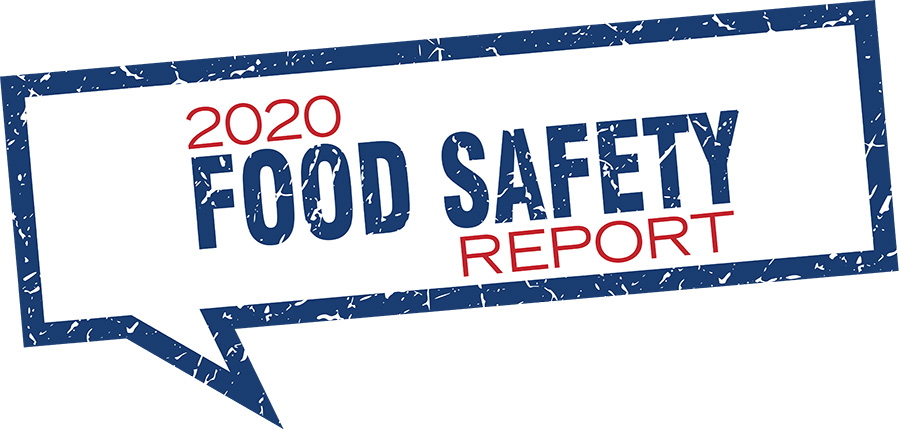Another recall just came across the news feed. A few minutes before that, there was a news flash about a foodborne outbreak. It got me to thinking: What is the correlation, if any, between the foodborne outbreaks and recalls?
I jumped into the U.S. Centers for Disease Control and Prevention’s (CDC) foodborne outbreak investigations reporting tool and compared them with recalls issued by the U.S. Department of Agriculture’s Food Safety and Inspection Service (FSIS). The latest data that matched both was from 2017 (the CDC hasn’t published anything newer).

Table of Contents:
I broke it down by lab-confirmed cases of illness, not the suspected cases or CDC estimates.
The first thing that jumps out at me is there were 136 confirmed investigations for Norovirus. That’s more than Salmonella (No. 2 on the list) and E. coli combined.
As an industry, we have always assumed Norovirus was a retail issue, meaning the person serving the product was the carrier. The data does tend to support this as most of the outbreaks occur in settings such as restaurants, schools, etc.
The No. 2 reason for confirmed foodborne outbreaks, as I mentioned, was Salmonella, with 114 confirmed cases.
What is interesting is FSIS had a single recall for Salmonella in 2017, yet approximately 26 percent of confirmed cases were related to products FSIS regulates.
Meanwhile, 23 percent of Salmonella outbreaks were traced to a product regulated by the U.S. Food and Drug Administration (FDA).
And the product in question for 50 percent of Salmonella outbreaks was never even identified. Our investigation system could not identify the cause for half of all Salmonella outbreaks.
The third-highest confirmed foodborne outbreak investigations resulted in a tie between Clostridium perfringens and E. coli, with 20 each.
E. coli from a meat product accounted for two investigations that resulted in 11 confirmed illnesses.
Clostridium perfringens, on the other hand, had 13 outbreaks related to products regulated by FSIS. It appears the majority of these outbreaks were related to mishandling at the retail level or by the consumer themselves.
The fifth-leading cause of confirmed foodborne outbreaks in 2017 was Campylobacter, with 18 outbreaks that resulted in 128 illnesses. Eight of those outbreaks were traced to FSIS-regulated products.
How does this compare with actual recalls? Of the top 5 pathogens confirmed to have caused a foodborne outbreak, there were no recalls for Norovirus, Clostridium perfringens or Campylobacter. Please note there were five recalls for process deviations that may or may not have an impact on these pathogens.
While there were eight recalls for misbranded product, 12 recalls for no inspection, 26 recalls for foreign material and 56 recalls for misbranding due to an undeclared allergen, there were no foodborne outbreaks related to any of these. Please remember, at least two people must become ill for it to be classified as a foodborne outbreak.
So, to answer my original question: No, there doesn’t really appear to be a correlation.
That leads me to my next question: Does this mean the system is working, or that it is broken?
I say it is working.
TOP PATHOGENS RELATED TO FOODBORNE OUTBREAK INVESTIGATIONS:
| Number Confirmed | Etiology | Typical Vector |
| 136 | Norovirus | Multiple |
| 114 | Salmonella | Multiple |
| 20 | Clostridium perfringens | Pizza, beef, chicken, turkey etc. |
| 20 | Escherichia coli, Enteroaggregative; Escherichia coli, Enteropathogenic | Salad, ground beef, lamb, flour |
| 18 | Campylobacter | Duck liver, chicken liver, beef, raw milk, oysters, chicken, turkey |
| 17 | Scombroid toxin | Fish, tuna |
| 14 | Ciguatoxin | Barracuda, guacamole, fish |
| 9 | Vibrio parahaemolyticus | Oysters raw |
| 7 | Listeria monocytogenes | Cheese fresco, caramel apple, cheese |
| 6 | Cyclospora cayetanensis | Blackberries, salsa, green onions |
| 5 | Hepatitis A | Unknown |
| 4 | Bacillus cereus | Fried rice, chicken stew, grilled chicken, shrimp scampi |
| 4 | Shigella flexneri | Chicken/mayonnaise |
| 3 | Clostridium botulinum | Seal oil, nachos and cheese, herbal tea |
| 3 | Mycotoxins | Mushrooms |
| 3 | Sapovirus | Cheese Pizza |
| 2 | Cryptosporidium | Unknown |
| 2 | Other - Chemical/Toxin | Cereals |
| 2 | Paralytic shellfish poison | Mussels/Clams |
| 2 | Staphylococcus aureus | Pulled pork, macaroni and cheese |
| 1 | Clostridium | Steak tacos |
| 1 | Giardia unknown | Raw oysters |
| 1 | Neurotoxic shellfish poison | Conch soup |
| 1 | Streptococcus Group A | Potatoes |
| 1 | Toxoplasma gondii | Venison |
| 1 | Trichinella | Walrus |
Industry has invested huge amounts of resources to control pathogens, improve allergen labeling and reduce foreign-material contamination in finished products. As an industry, we are controlling pathogens about as well as we can. One way to think of it is like this: There are approximately 316 million Americans who eat at least two meals a day as an average. That equates to more than 230 billion meals consumed in America per year, and that is a very conservative estimate. Compare that with the roughly 674 confirmed food outbreaks per year and I would say we are doing a pretty good job of keeping our food supply safe.
I also think we all agree that even one person getting ill from our products is one too many. So, what can we do to reduce pathogen-related foodborne outbreaks even more? I am not sure there is anything we can do across the table in the slaughter or processing facilities that is truly viable. I just don’t see any silver bullets available to the industry currently that would have any true impact.
Where control can work is on the farm. If the animal comes in to the processing plant free of pathogens, it will result in a dramatic decrease in the number of foodborne outbreaks.
For all of us this is a significant challenge. Those with direct relationships with farmers can form partnerships and work through best practices to include feedback on contamination levels, etc. If you are vertically integrated, you have even more control.
Salmonella controls are much harder. Even if you exclude it from the surface of your products, it may be found internally. Once it is present in food animals or plants, the only way for the consumer to effectively stop it is to cook it to lethality.
When you talk with the person who raised the animals, the last thing they want is to send you animals that have a pathogen in them. In fact, the different lobbies representing farmers and ranchers don’t want anyone to actually look into it as it has the potential to create a whole new herd of cash cows for the attorneys who sue on behalf of people who get sick. I think this is an area in which we need to get our legislators, extension offices, scientists, etc., involved so we can come up with solutions instead of finger pointing. But, of course, that’s easier said than done.
Another area of concern is cross-contamination either in the home or in retail preparation. When going through the data and looking up cases, it is apparent we aren’t teaching people how to effectively clean between preparing different products in the home. Cross-contamination is also listed as the source for several ready-to-eat products that were contaminated at the retail level (restaurants).
What are some of the things we recommend to our clients to help mitigate the risk of foodborne outbreaks?
If a product that makes someone ill is traced back to your facility, you can expect hordes of lawyers to be contacting you. To help keep them away, we recommend you focus on sanitation, using sanitizers that are effective against the pathogens of concern in your products. Follow the old adage, “keep it cold, keep it covered and keep it clean.” As I mentioned earlier, in the case of internal Salmonella contamination, and it is there, the only truly viable solution is to properly cook the product prior to consumption.
With Norovirus, we strongly recommend wholesale manufactures put plans in place to identify and exclude ill workers from exposure to production or other employees.
Ensure your cooking instructions are clear and easily followed.
Safe-handling instructions should be shared with your customers, regardless of whether they are a restaurant or other retail preparation site. The more you can educate your customers, the better you protect your brand.
Maintain a robust integrated food-safety system that is well documented and fully supported. Break the tendency to do the minimum required by regulators and ensure you can defend your products, processes and, ultimately, your brand.
And finally, remember you can’t rely on regulators to ensure you are making a safe product. That is up to you and your team. NP





Report Abusive Comment